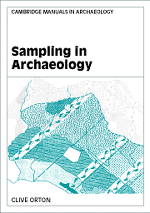Book contents
- Frontmatter
- Contents
- List of illustrations
- List of tables
- Acknowledgements
- 1 All the world's a sample
- 2 A little of what you fancy?
- 3 If this is the sample, what was the population?
- 4 Covering the ground
- 5 What's in a site?
- 6 The answer lies in the soil
- 7 ‘But many sanguine people hope, to see them through a microscope’
- 8 ‘In its depths, what treasures’
- 9 Beyond random sampling
- Appendix
- Bibliography
- Index
5 - What's in a site?
Published online by Cambridge University Press: 05 June 2012
- Frontmatter
- Contents
- List of illustrations
- List of tables
- Acknowledgements
- 1 All the world's a sample
- 2 A little of what you fancy?
- 3 If this is the sample, what was the population?
- 4 Covering the ground
- 5 What's in a site?
- 6 The answer lies in the soil
- 7 ‘But many sanguine people hope, to see them through a microscope’
- 8 ‘In its depths, what treasures’
- 9 Beyond random sampling
- Appendix
- Bibliography
- Index
Summary
Introduction
In this chapter we move down a scale, from the region to the site, and look at problems that arise in sampling at this level, and some of the solutions that have been suggested. The problems are not simply those of the regional scale writ small (see Cherry et al. 1978, 151–7), although there is overlap, and indeed there is a continuum of scale from the small regional (e.g. parish) survey to the large site (e.g. Gaffney and Tingle 1985).
Even site survey is not a homogeneous topic, because the term ‘site’ itself has many meanings. Here we need to distinguish primarily between the development site – an area of land subject to some form of proposed commercial, agricultural or infrastructural development – and the archaeological site, already discussed in detail in chapter 4 (pp. 67–111). For the former, the broad aim is to detect the presence and extent of any significant archaeological remains on the site, with a view either to recording them before damage or destruction (preservation by record), or to mitigating the damage by redesign of the proposed development (preservation in situ). For the latter, the aim may simply be to determine the extent and character of a site (perhaps newly discovered in a regional survey), or there may be a more site-specific research design. The aims and methods may vary according to whether the site is largely invisible on the ground surface, or whether it has extensive visible remains, and also whether it is likely to be shallow or deeply stratified.
- Type
- Chapter
- Information
- Sampling in Archaeology , pp. 112 - 147Publisher: Cambridge University PressPrint publication year: 2000



